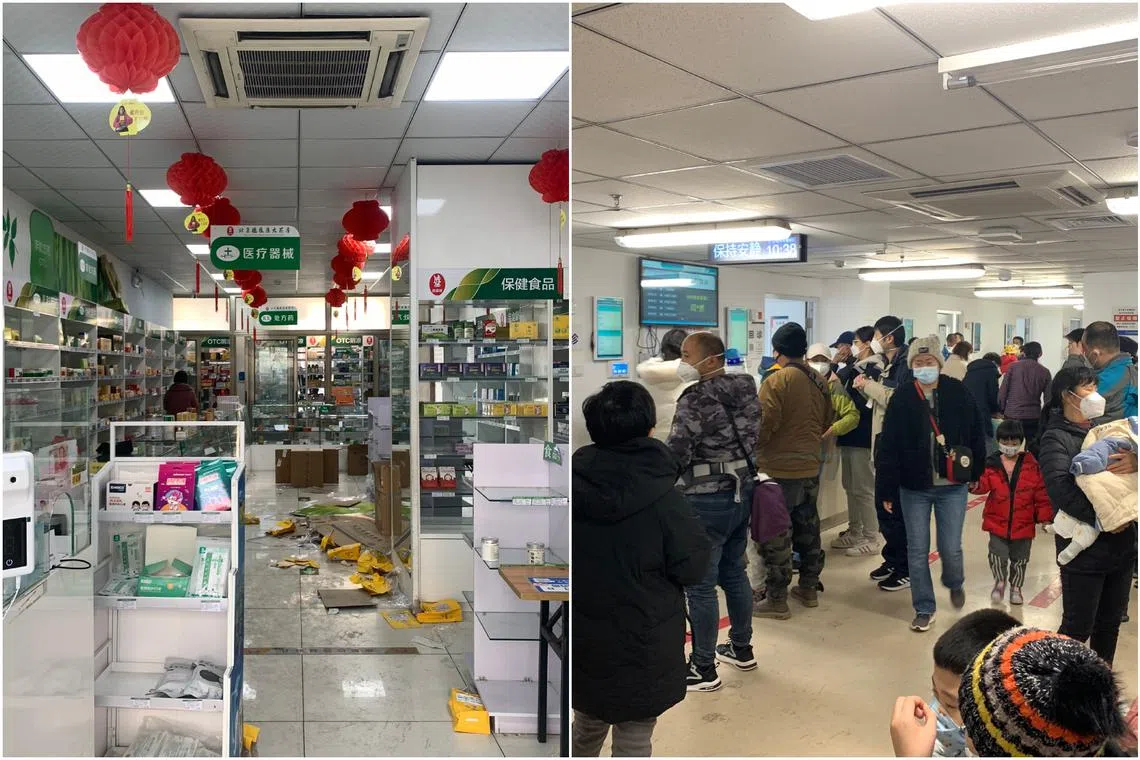China braces itself for fresh Covid-19 wave: Empty shelves in pharmacies, long lines at fever clinics
Sign up now: Get ST's newsletters delivered to your inbox

Empty shelves at a pharmacy and a crammed waiting room in the fever clinic of a children's hospital in Beijing on Friday.
ST PHOTOS: DANSON CHEONG
Follow topic:
BEIJING - China is bracing itself for a fresh wave of infections, two days after the national health authority abruptly dismantled stringent Covid-19 protocols,
This has sparked concerns that the restrictions were relaxed without sufficient notice or preparation. Doubts have also been raised about the true infection numbers since testing and reporting protocols were relaxed.
Long lines formed outside fever clinics on Friday at hospitals in Beijing’s Chaoyang district, the epicentre of the outbreak, while shelves at pharmacies were emptied of fever medication, antigen test kits and even face masks.
The National Health Commission on Wednesday suddenly rolled back longstanding measures to clamp down on the virus, which has battered the economy and triggered protests across the country.
The authorities have now allowed infected people to isolate at home instead of being taken to a hospital, scrapped testing requirements and lifted cross-provincial travel restrictions.
The abrupt turnabout has stoked worries among those who have treated the virus as a deadly threat for the past three years.
At the Children’s Hospital of the Capital Institute of Paediatrics, close to 70 people, including parents clutching their children, waited for more than an hour to be called to see a doctor on Friday morning.
But the 100 or so people in line at Chaoyang Hospital had it worse – queueing up in sub-zero temperature outside its fever clinic. One woman in line said she developed a 39.4 deg C fever the day before and had no medication to alleviate her symptoms.
“I’ve never had fever this high, and I felt like death warmed over,” she said weakly.
At least four pharmacies The Straits Times went to had run out of fever and cold medication, as well as antigen kits. Staff at a pharmacy in Beijing’s Dongcheng district chained its doors shut at 2pm.
“We are out of all fever, cough, cold medication, and we had just restocked in the morning,” said a staff member.
The Beijing health authorities on Friday raised eyebrows when they reported a total of just 2,673 new infections for Thursday, a sharp drop from the nearly 4,000 cases reported on Wednesday before the National Health Commission announced the new nationwide relaxation. It is hard to gauge how widespread the outbreak is, as infected people no longer need to report to their communities and testing is no longer required.
Overall, 16,797 new infections were recorded on Thursday across the country, a drastic fall from the peak of over 40,000 cases in late November. There were 21,439 cases nationwide on Wednesday.
Molecular virology professor Jin Dong-Yan of the University of Hong Kong said it was difficult to say how long China’s Covid-19 surge will last.
A major flare-up in Hong Kong earlier this year took two or three months to peter out, while other places including Taiwan and Singapore took many more months to flatten the curve after they opened up, said Prof Jin. “China is so big, it’s hard to say what the pattern of cases will be,” he said.
The country’s abrupt exit from zero-Covid is also taking place in winter, when cases of seasonal flu peak.
“People are not testing as regularly, but China also has no system for reporting results from antigen tests, so there is no way of telling how many positive cases there are. The current official case counts are meaningless,” Prof Jin said.
Despite having nearly all Covid-19 curbs lifted, streets in Beijing were quiet with light traffic, while shops and restaurants were empty.
An advisory sent out to Singaporeans in Beijing on Friday by the Singapore embassy, noting an increase in Covid-19 transmissions, recommended that Singaporeans avoid crowded places and stock up on essential supplies like medicine and antigen test kits.
As high as 90 per cent of the population could end up being infected, said a health expert
In the first wave, about 60 per cent could catch the virus, and a subsequent surge could see 80 per cent to 90 per cent of the population infected, said Dr Feng Zijian, former deputy director of the Chinese Centre for Disease Control and Prevention, at an online meeting organised by Tsinghua University on Tuesday.
Findings released in May from modelling done of the Omicron variant by Shanghai’s Fudan University estimated that nearly 1.6 million people could die if the Covid-19 reins were suddenly let loose. China has reported about 5,200 deaths from Covid-19 since the start of the pandemic.
Only last month did the health authorities say they were going to ramp up vaccination of the elderly,
“I didn’t expect this policy retreat to be so dramatic,” said Dr Huang Yanzhong, a senior fellow for global health at the Council on Foreign Relations and a professor of global health studies at Seton Hall University.
“You want to have a sequence. I thought they would introduce more flexibility, highlight their preparation in increasing the vaccination rate and improving resources. But I didn’t expect they would go that far,” he said of the sudden U-turn in policy.

